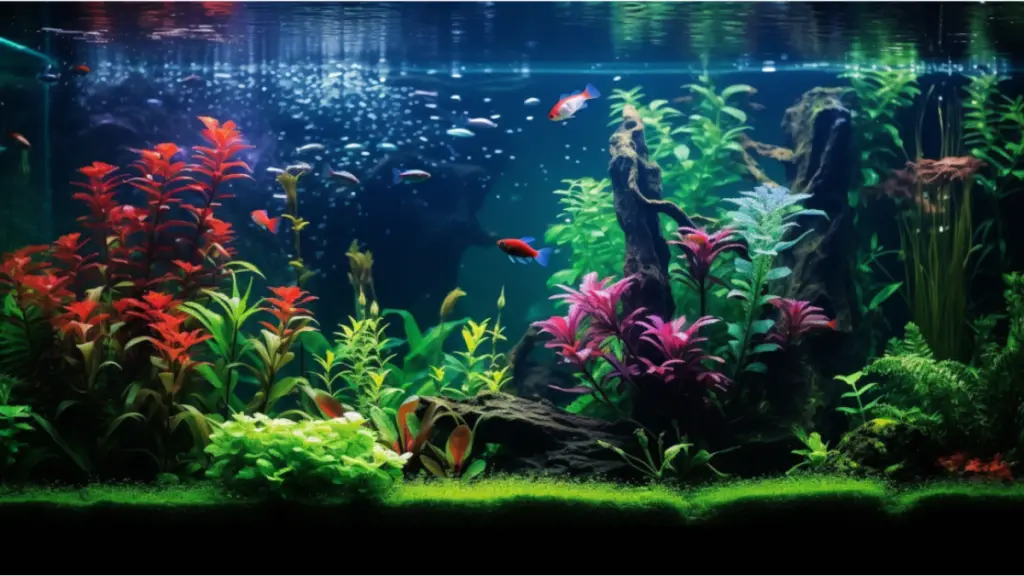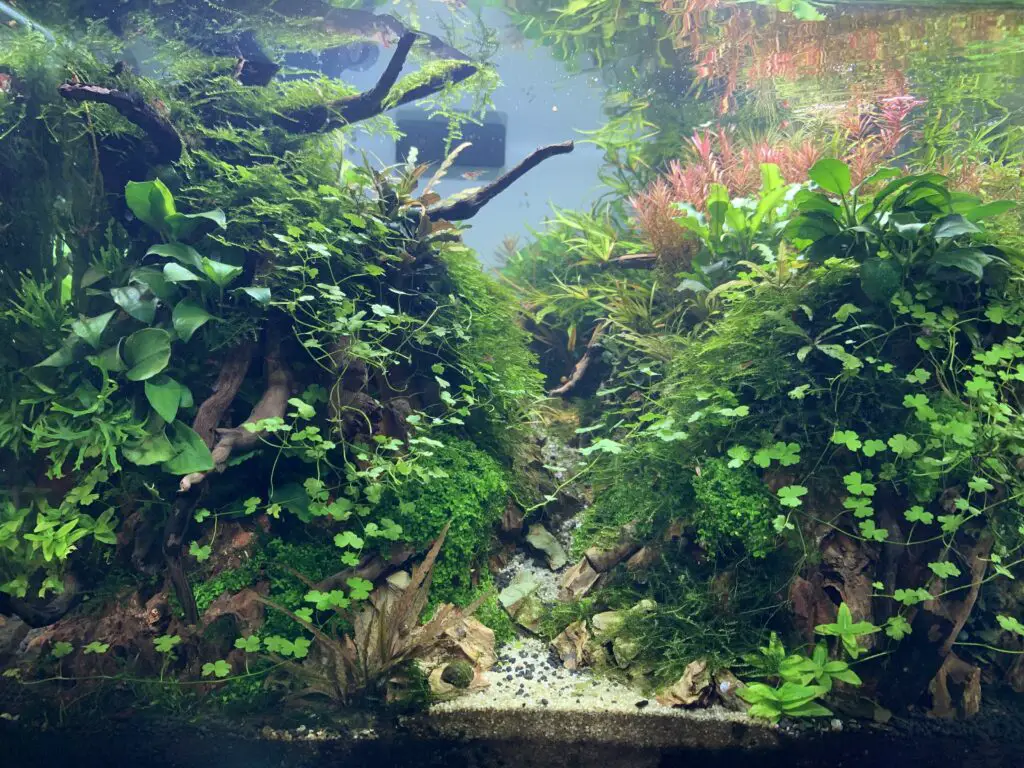You’re a passionate aquarist, keen on creating the perfect underwater garden. Yet, striking the right balance between lighting, CO2, and nutrients for your aquatic plants can be tricky. Don’t worry; we’ve got your back.
This guide will reveal how to optimize these elements for thriving plant growth. You’ll soon have a vibrant, healthy tank that’s a joy to behold and a testament to your dedication to nurturing life.
- Key Takeaways
- Understanding the Role of Lighting in Plant Growth
- The Impact of Carbon Dioxide Levels on Aquatic Plants
- Methods for Adding Carbon Dioxide to Your Planted Tank
- Essential Nutrients for Optimal Plant Growth
- Adjusting Nutrient Levels for Different Lighting Conditions
- Comparing Growth Rates Among Different Aquatic Plants
- The Influence of Lighting and CO2 on Plant Appearance
- Troubleshooting Common Plant Growth Problems
- Strategies for Experimenting With Lighting and Nutrient Levels
- Frequently Asked Questions
- How Can I Measure the Current Lighting Level in My Planted Tank?
- Are There Specific Types of Fish That Can Improve the Carbon Dioxide Level in My Aquarium?
- Can I Use Homemade Solutions to Add Carbon Dioxide to My Planted Tank?
- Is There a Specific Timeline for Adding Nutrients to the Aquarium for Optimal Plant Growth?
- How Can I Prevent Fish From Eating or Damaging the Plants in My Planted Tank?
- Conclusion
Key Takeaways
- Lighting level affects plant growth and algae problems.
- Carbon dioxide is essential for aquatic plant growth.
- Carbon dioxide can be easily and cheaply added using a yeast fermentation bottle.
- Aquatic plants require a balance of macronutrients and micronutrients for optimal growth.
Understanding the Role of Lighting in Plant Growth
You’ve got to understand that the lighting level in your tank plays a crucial role in your plant’s growth and even impacts potential algae problems. It’s not just about cranking up the lights.
You’re aiming to maximize photosynthesis efficiency, which requires finding the right balance of light intensity. Too little light and your plants won’t thrive. Too much, and you’re inviting algae to the party.
Consider the types of plants you’ve got. Some need more light, others less. Adjust accordingly. Remember, you’re serving these plants, helping them to flourish.
A well-lit tank isn’t just good for your plants, it’s good for your whole ecosystem and visually pleasing. So, shine the right amount of light on your aquatic friends.
The Impact of Carbon Dioxide Levels on Aquatic Plants
Consider the role of carbon dioxide in your aquatic setup. It’s a key factor for healthy vegetation, with higher levels often leading to more robust growth and potential algae problems.
The relationship between carbon dioxide and algae growth in planted tanks is a delicate balance you must manage. Too much carbon dioxide, and you risk triggering excessive algae growth.
However, the benefits of adding carbon dioxide to low or moderate-lighting tanks can’t be ignored. It aids in photosynthesis, promoting healthier and more vibrant plant growth.
Properly managing carbon dioxide levels serves your aquarium’s inhabitants and contributes to a healthier ecosystem.
Remember, every tank is unique, so there’s no one-size-fits-all approach. Monitor your plants and adjust as needed.
You’ve got this!

Methods for Adding Carbon Dioxide to Your Planted Tank
Incorporating carbon dioxide into your aquarium can be a simple and inexpensive process. One popular method for DIY CO2 systems is using a yeast fermentation bottle. You’ll mix yeast and sugar in a bottle, and as the yeast consumes the sugar, it produces CO2 that can be directed into your tank with a bit of tubing.
Another method is using liquid carbon supplements. They’re easy to use; add to your tank as directed. However, they have their pros and cons. Plus, they’re fuss-free and great if you’re not into DIY. The downside is they can be pricier over time, and some aquarists argue they’re not as effective as CO2 gas.
Essential Nutrients for Optimal Plant Growth
For your aquatic greenery to thrive, it’s crucial to ensure they get a sufficient mix of macronutrients and micronutrients. Regular nutrient supplementation is necessary as it helps prevent nutrient deficiencies that can stunt their growth.
Here’s a simple table to guide you:
| Nutrient | Function | Symptoms of Deficiency |
|---|---|---|
| Nitrogen | Promotes healthy leaf growth | Yellowing, stunted growth |
| Phosphorus | Aids in energy transfer | Red/purple leaves, slow growth |
| Potassium | Boosts overall plant health | Yellowing at leaf edges, weak stems |
Adjusting Nutrient Levels for Different Lighting Conditions
You’ll need to adjust the nutrient levels in your aquarium based on the lighting conditions to ensure a healthy aquatic environment.
In low lighting, nutrient deficiencies are common. You can combat this by regularly monitoring nutrient levels and supplementing as needed. This will encourage plant growth and keep your fish happy and healthy.
When dealing with high lighting, balancing nutrient levels becomes crucial. Too many nutrients can lead to unwanted algae growth. Not enough, and your plants may struggle. Adjust accordingly, always keeping in mind the well-being of your aquarium’s inhabitants.

Comparing Growth Rates Among Different Aquatic Plants
Different aquatic species will exhibit varied growth rates under identical conditions, so it’s important to understand these differences when setting up your aquarium.
- Comparing growth rates:
- Some plants, like Anubias, are slow growers even under optimal conditions.
- Others, like Amazon Sword plants, thrive under high lighting and CO2 levels.
- Nutrient requirements:
- These vary from species to species, with some needing more macronutrients or micronutrients than others.
- Adjusting these levels can impact growth rates.
- Comparing lighting levels, CO2 levels:
- While some plants do well under low to moderate lighting and CO2, others need higher levels for optimal growth.
The Influence of Lighting and CO2 on Plant Appearance
Understanding how lighting and carbon dioxide affect aquatic plants’ appearance can significantly enhance the aesthetic appeal of your aquarium. You may have noticed the effect of lighting intensity on plant growth rate.
More light often leads to faster growth and, in some cases, can even change the color of your plants. However, there’s a sweet spot – too much light might lead to algae problems.
Now, let’s talk about carbon dioxide. The relationship between carbon dioxide levels and plant health is significant. Carbon dioxide is a key ingredient for photosynthesis. Without it, your plants can’t grow. But just like with lighting, balance is key. Too little can hinder growth, while too much might harm your fish.
Understanding and managing these factors will help you create a stunning aquarium.
Troubleshooting Common Plant Growth Problems
Let’s dive into some common issues you might encounter with growing your aquatic flora and how to troubleshoot them effectively. You’re not alone in this; many aquarists struggle with common plant diseases and preventing algae growth.
- Common plant diseases
- Yellowing leaves: this could be due to nutrient deficiency. Test your water and adjust accordingly.
- Aquatic plant rot: often a result of poor water quality. Regular water changes can help prevent this.
- Preventing algae growth
- Algae thrive in conditions of excess nutrients and light. Monitor your tank’s lighting and nutrient levels closely.
- Regular maintenance: keep your tank clean and do regular water changes.
Strategies for Experimenting With Lighting and Nutrient Levels
Moving on from troubleshooting growth problems, let’s discuss strategies for experimenting with lighting and nutrient levels.
You’re serving others by making your space a nurturing environment. Now focus on balancing lighting and CO2. Remember, too much light without enough CO2 could lead to an algae problem. So, start with low to moderate lighting, and observe how your plants respond. Adjust as needed.
Regarding nutrient dosing, start small. Use a complete trace element mix to ensure your plants get the needed micronutrients. Monitor your plants’ growth and adjust the dosage accordingly.
This balancing act takes patience, but it’s worth it. You’ll discover the optimal conditions for your plants to thrive by experimenting and observing. Keep giving, keep growing.
Frequently Asked Questions
Conclusion
In conclusion, you’ve got the power to optimize your planted tank’s plant growth. It’s all about balancing light, CO2, and nutrients.
Remember, each plant’s needs vary – it’s not one-size-fits-all. Experiment with lighting and nutrient levels and monitor your plants’ responses.
Don’t overlook the role of regular maintenance. It might take some trial and error, but with patience, you’ll create a thriving aquatic garden!


